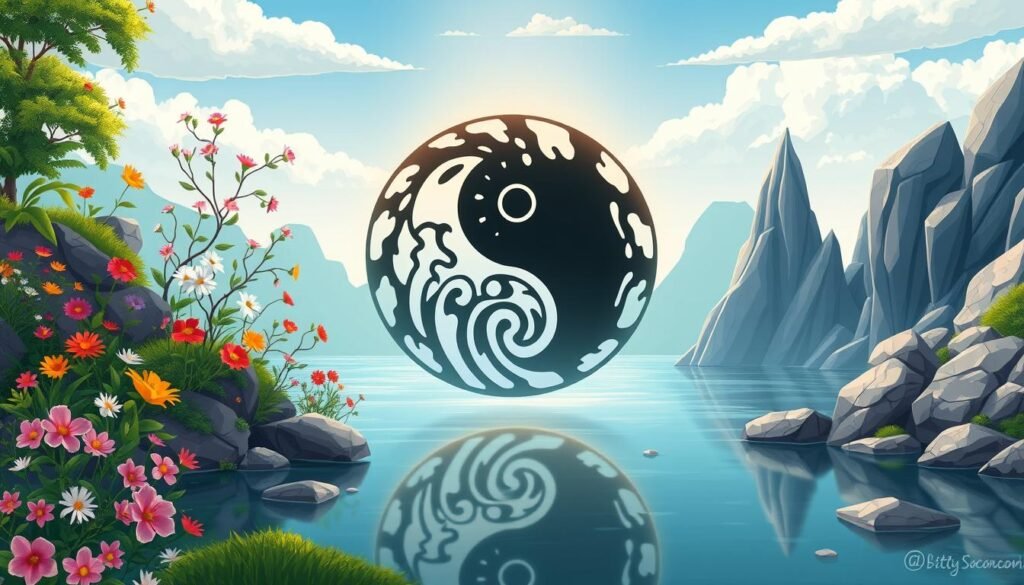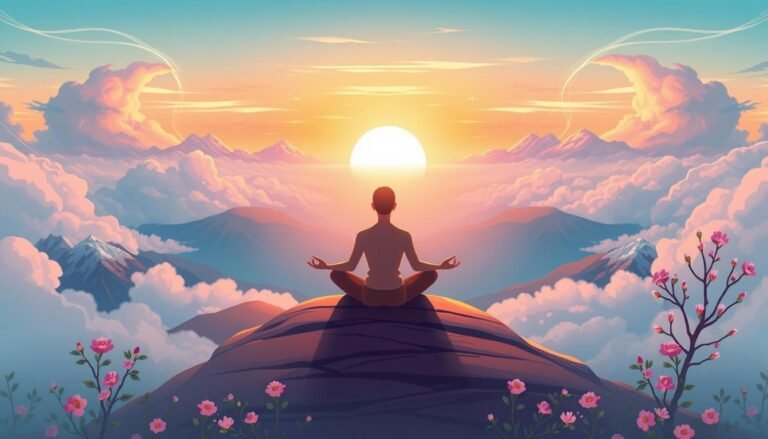What Does Yin-Yang Teach Us About Finding Balance?
“The only way to make sense out of change is to plunge into it, move with it, and join the dance.” – Alan Watts
This quote by Alan Watts captures the heart of yin-yang. It teaches us about life’s dualities and how to find harmony. The ancient Chinese philosophy of yin-yang shows us that opposites can work together.
Finding balance in today’s fast world is tough. But yin-yang teaches us that opposites are not just needed, but also help each other. This idea can change how we see mental health, relationships, and growing as a person.
Studies show that those who see life through yin-yang do better with stress. They adjust their ways to fit the situation, leading to better emotional control. This balance isn’t about getting rid of the bad, but finding peace between opposites.
Exploring yin-yang further, we’ll see how it can help us deal with life’s challenges. It guides us in finding the balance we all look for.
Understanding the Yin-Yang Philosophy
The yin-yang philosophy is rooted in ancient wisdom. It teaches us about balance and harmony. This idea comes from China and has shaped Eastern thought for centuries.
Origins of Yin-Yang
Yin-yang’s roots go back to ancient China. It first appeared in texts like the I Ching. During the Zhou dynasty, yin meant the shady side of a slope, and yang meant the sunny side.
Core Principles of Yin-Yang
Yin-yang is all about complementarity. It shows that opposing forces work together. This ancient wisdom talks about finding balance between light and dark, hot and cold, or active and passive.
Symbolism and Representation
The yin-yang symbol is iconic. It shows black and white halves, representing opposing forces. The small dots in each half show that each force has the seed of its opposite. This symbol shows the balance and constant interaction of energies in the universe.
“When yin and yang are in harmony, all things will be produced; when they are not, all things will be harmed.” – Zhuangzi
Understanding yin-yang gives us insights into finding balance in life. It teaches us that opposite forces can work together and are connected in the natural world.
The Duality of Opposing Forces
Yin and yang show us the balance of opposing forces in life. They teach us about the fine balance in nature and within us. This balance is crucial for growth and happiness.
In today’s fast world, finding balance is hard. Many don’t get enough sleep, and working too much is seen as good. This imbalance causes stress, anxiety, and makes us feel disconnected from our bodies.
“The constant flux between yin and yang creates harmony, benefiting individuals, societies, and cultures.”
To find balance, we need to accept both active and passive parts of our lives. This balance is essential for a complete approach to well-being. Here are some ways to achieve it:
- Practicing mindfulness and meditation
- Engaging in gentle exercises like yoga or tai chi
- Alternating periods of work with rest and relaxation
- Listening to our body’s signals and responding with compassion
By understanding the balance of opposing forces, we can create harmony in our lives. This balance helps us face challenges more easily and find joy in our daily lives.
Applying Yin-Yang to Mental Health
The concept of yin-yang offers a fresh view on mental health. It sees our well-being as a balance between good and bad forces. This approach highlights how our mental states are connected.
Eastern vs. Western Approaches to Mental Well-being
Western psychology used to treat mental illness alone. But Eastern philosophies look at life’s bigger picture. They see how our physical, emotional, and spiritual sides are linked. This view is now more popular in the West, with yoga and mindfulness gaining fans.
Holistic Perspective on Psychological Balance
A holistic view of mental health stresses the need for balance in life. This includes finding a good balance between work and personal time. Too much screen time can make us feel isolated and anxious. Taking breaks and disconnecting from screens can help us find peace.
Embracing Emotional Complexity
Yin-yang theory teaches us to accept all our emotions. It says both good and bad feelings are part of our lives. By accepting this, we can strive for a more balanced mind.
“The yin-yang symbol teaches us that opposites are interconnected and interdependent. In mental health, this means acknowledging both our strengths and vulnerabilities.”
Using yin-yang in mental health leads to a balanced, mindful way of living. It encourages harmony in all parts of our lives. This path leads to greater peace and better mental health.
Finding Balance Through Yin-Yang
Yin-yang philosophy is a powerful tool for achieving harmony in life. It teaches us to balance acceptance (yin) with action (yang) for better mental health. By understanding this duality, we can face life’s challenges more easily and with strength.

Acceptance means knowing what we can’t change, while action is about improving what we can. This balance helps us manage our feelings better. Studies show that naming our emotions can make them less intense, helping us control our feelings.
How we handle emotions varies across cultures. North Americans often try to avoid negative feelings, while East Asians see them as part of life’s balance. This acceptance might help us handle emotions more complexly and with better control.
“Finding balance is not about perfection, but about customizing your approach to fit your unique needs and circumstances.”
To bring yin-yang balance into your life, try these practices:
- Practice yin yoga for stillness and self-awareness
- Spend time in nature to promote mindfulness
- Prioritize early bedtime for relaxation and hormonal balance
- Engage in slow-paced activities like reading or massages
- Use breathing exercises to induce relaxation before bed
Remember, balance changes with life’s phases or situations. By embracing both yin and yang, you can find inner peace and live a more harmonious life.
Harmony and Conflict: Two Sides of the Same Coin
Life often gives us choices that seem to go in opposite ways. This shows us the balance and peace taught by the Yin-Yang philosophy.
Practicing Forgiveness
Forgiveness is a strong tool for harmony. It’s not about forgetting or agreeing with wrongs, but about healing and moving on. By forgiving, we open up to growth and mindfulness.
Cultivating Empathy
Empathy helps connect different views. By seeing things from others’ perspectives, we understand and lessen disagreements. This aligns with the Yin-Yang idea of being connected, leading to social peace.
The Art of Compromise
Compromise is crucial for keeping relationships balanced. It’s like the Yin and Yang, where each side gives and takes. A study showed that those who compromise are happier and less stressed at work.
“True harmony requires a balance of opposing forces.”
By following these ideas, we can deal with life’s challenges while keeping peace inside. The Yin-Yang shows us harmony isn’t about avoiding conflict. It’s about finding balance in life’s contrasts.
Integrating Yin and Yang Energies in Daily Life
Ancient wisdom teaches us about the balance of Yin and Yang energies. These forces, rooted in Chinese philosophy, are key to our equilibrium. Yin is stillness and reflection, while Yang is action and vigor.
To live in harmony, balancing these energies is crucial. Here’s how to do it:
- Embrace Yang through goal-setting and high-intensity workouts
- Nurture Yin with meditation and self-care practices
- Alternate between social interactions (Yang) and solitude (Yin)
- Balance work commitments with restorative rest periods
Mindfulness helps spot imbalances. Feeling overwhelmed? It might mean too much Yang. Add more Yin with yoga or walks in nature. Lack motivation? Boost Yang with exercise or a tough project.
“The harmony of the universe is maintained through the dance of Yin and Yang.”
The aim is not to suppress one energy but to find harmony between them. By integrating Yin and Yang in your daily life, you’ll feel better and more alive.
The Yin-Yang Approach to Yoga and Physical Well-being
Yoga follows the yin-yang philosophy, aiming for total balance. It mixes active and passive parts for a workout that benefits both body and mind.
Yang Practices for Vitality and Strength
Yang yoga, like Vinyasa or Ashtanga, is all about moving postures. These sequences boost strength, flexibility, and endurance. They energize the body and mind, bringing vitality and power.
Yin Practices for Restoration and Flexibility
Yin yoga, starting in the late thirties, involves holding poses for a long time. It works on connective tissues, improving flexibility and joint movement. Yin yoga also relaxes the body and promotes mindfulness.
Balancing Active and Passive Elements in Exercise
Mixing yin and yang yoga offers a full approach to health. This mix reduces stress, boosts focus, and increases self-awareness. It supports healing by covering physical, mental, and energetic health aspects.
- Yang yoga builds strength and endurance
- Yin yoga enhances flexibility and joint mobility
- Combined practice aids stress reduction
- Balancing yin and yang promotes overall vitality
By using both yin and yang in yoga, people reach balance. This balanced method matches life’s natural flow. It supports physical health and mental clarity through mindful movement and stillness.
Embracing Change and Impermanence
The ancient wisdom of yin-yang teaches us to accept life’s constant changes. This idea helps us deal with tough times by knowing better days are ahead. It’s like taking care of a garden – planting, growing, and sometimes starting over.
Studies show that feeling awe can make us feel good. By stepping out of our daily routines and trying new things, we grow. This matches the yin-yang idea of finding balance in life.
“The only constant in life is change.” – Heraclitus
Understanding that everything changes makes us more flexible and strong. Saying small positive things to ourselves helps us feel connected. By embracing yin-yang, we learn to handle life’s ups and downs.
The Tao de Ching, written 2,500 years ago, teaches about balance and change in 81 short verses. Its wisdom, along with the yin-yang symbol, shows how opposites come together. It captures the balance of nature’s constant changes.
- Embrace unique experiences
- Reflect on life’s changes
- Practice small affirmations
- Cultivate flexibility and resilience
By using these ideas, we can find balance through yin-yang. We learn to accept both calm and movement in our lives. This ancient wisdom helps us deal with today’s world.
Conclusion
The ancient philosophy of yin-yang teaches us about balance in life. It shows us how to deal with life’s ups and downs. This idea of balance is not about always being calm, but about understanding life’s natural changes.
In Western society, Yang energy often rules, leading to stress and burnout. This imbalance can harm our health and relationships. Recognizing these signs is key to finding balance again.
Practices like yoga and meditation can help balance our energies. Spending time in nature also plays a role. These activities help us feel better overall.
Traditional Chinese Medicine gives us tools to keep balance. It includes acupuncture, herbal remedies, and lifestyle changes. By using these methods, we can live a more balanced and fulfilling life. Remember, finding balance is a journey that never ends.
Source Links
- Yin and Yang: How Ancient Ideas of Balance Can Help You
- Finding balance with yin and yang energy — Yogi’s Home Yoga
- Yin and Yang; Finding Balance as a Whole ⋆ Earth and Water
- Understanding the Yin-Yang Principle in Philosophy
- Yinyang (Yin-yang) | Internet Encyclopedia of Philosophy
- Yin & Yang: Symbolic Meaning & Connection to Yoga
- Finding Balance
- Yin and yang
- Yin and Yang
- Frontiers | The Yin–Yang Definition Model of Mental Health: The Mental Health Definition in Chinese Culture
- Yin & Yang, Explained: How To Apply This Ancient Principle To Modern Life – Evolve Wellness Centre
- The Way to a Harmonious Life Is Found by Achieving Balance Between Yin and Yang
- Balancing the yin and the yang…and finding peace! — The Vibrancy Hub
- CREATING THE IDEAL WORK-LIFE BALANCE WITH YIN & YANG
- How yin and yang principles can guide ethical decision-making
- What Is The Meaning Of The Yin And Yang Symbol? The Ancient Chinese Representation Of… – Yome Yoga
- The Double Edged Sword: Examining the Duality of Two – FasterCapital
- Unlocking Harmony: How Yin and Yang Can Transform Your Modern Life
- Yin and Yang Energies: Finding the Balance
- Finding balance with Yang to Yin
- Balancing Yin and Yang
- Importance of Yin and Yang Yoga Practice: Achieving Balance and Harmony | Lifestyle Yoga World
- Eclipsed? Seeing the SUNNY side of totality
- Blog | Arthur Kilmurray | Explorations in Yoga, the Re-Awakening of the Sacred Feminine, and the Emerging Planetary Consciousness
- Lao Tsu, the Tao and Balance
- Yin and Yang: Finding Balance in an Unbalanced World – Louna Hoffmann
- TCM Yin and Yang: The Key to Achieving Balance and Harmony








